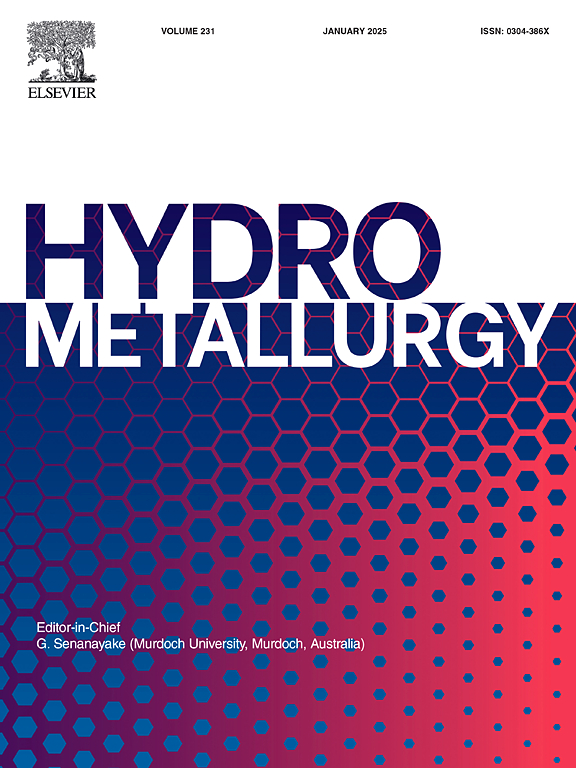Synthesis of coal-based activated carbon via one-step activation and its adsorption and stripping performance for gold thiosulfate complexes
IF 4.8
2区 材料科学
Q1 METALLURGY & METALLURGICAL ENGINEERING
引用次数: 0
Abstract
The challenges associated with recovering gold from leachates restrict the wide applicability of thiosulfate systems. This study developed a facile one-step activation strategy for synthesizing coal-based activated carbon from low-cost, accessible bituminous coal precursors; the activated carbon was subsequently used to adsorb gold from thiosulfate solutions. The optimal conditions for synthesizing coal-based activated carbon were investigated, along with the effects of pH, temperature, and initial gold concentration on [Au(S2O3)2]3− adsorption by the coal-based activated carbon. The structural and surface properties of the adsorbent were analyzed before and after gold adsorption, which revealed that the initially smooth surface morphology of raw coal became porous after activation and that the surface was loaded with ![]() SCN groups. The adsorption process followed pseudo-second-order kinetics and was described using the Freundlich model. The adsorption of [Au(S2O3)2]3− on the coal-based activated carbon was a fast endothermic process. The adsorption equilibrium was attained within 60 min, at a gold concentration of 10 mg/L. The maximum adsorption capacity of gold on the coal-based activated carbon was 3.29 mg/g, at a gold concentration of 80 mg/L at 45 °C. During the gold adsorption, ligand exchange occurred between the [Au(S2O3)2]3− ions in the solution and the
SCN groups. The adsorption process followed pseudo-second-order kinetics and was described using the Freundlich model. The adsorption of [Au(S2O3)2]3− on the coal-based activated carbon was a fast endothermic process. The adsorption equilibrium was attained within 60 min, at a gold concentration of 10 mg/L. The maximum adsorption capacity of gold on the coal-based activated carbon was 3.29 mg/g, at a gold concentration of 80 mg/L at 45 °C. During the gold adsorption, ligand exchange occurred between the [Au(S2O3)2]3− ions in the solution and the ![]() SCN groups on the coal-based activated-carbon surface, ultimately facilitating the adsorption of Au(I) in the solution on the activated-carbon surface. Moreover, the [Au(S2O3)2]3−-loaded coal-based activated carbon could be effectively eluted by thiosulfate. Hence, this study provides theoretical guidance and a practical basis for the adsorption of gold from thiosulfate leachates using coal-based activated carbon while facilitating clean, high-value utilization of coal resources.
SCN groups on the coal-based activated-carbon surface, ultimately facilitating the adsorption of Au(I) in the solution on the activated-carbon surface. Moreover, the [Au(S2O3)2]3−-loaded coal-based activated carbon could be effectively eluted by thiosulfate. Hence, this study provides theoretical guidance and a practical basis for the adsorption of gold from thiosulfate leachates using coal-based activated carbon while facilitating clean, high-value utilization of coal resources.
一步活化煤基活性炭的合成及其对硫代硫酸金配合物的吸附和剥离性能
从渗滤液中回收金的挑战限制了硫代硫酸盐系统的广泛适用性。本研究开发了一种简单的一步活化策略,用于从低成本,可获得的烟煤前体合成煤基活性炭;随后用活性炭吸附硫代硫酸盐溶液中的金。研究了煤基活性炭的最佳合成条件,考察了pH、温度和初始金浓度对煤基活性炭吸附[Au(S2O3)2]3−的影响。对吸附金前后吸附剂的结构和表面性能进行了分析,发现原煤表面由最初光滑的表面形貌在活化后变得多孔,表面加载了SCN基团。吸附过程遵循准二级动力学,并采用Freundlich模型进行描述。煤基活性炭对[Au(S2O3)2]3−的吸附是一个快速吸热过程。当金浓度为10 mg/L时,吸附在60 min内达到平衡。在45℃条件下,当金浓度为80 mg/L时,煤基活性炭对金的最大吸附量为3.29 mg/g。在金吸附过程中,溶液中的[Au(S2O3)2]3−离子与煤基活性炭表面的SCN基团之间发生配体交换,最终促进了溶液中Au(I)在活性炭表面的吸附。此外,硫代硫酸盐可以有效地洗脱负载[Au(S2O3)2]3−的煤基活性炭。因此,本研究为煤基活性炭吸附硫代硫酸盐浸出液中的金,促进煤炭资源的清洁、高价值利用提供了理论指导和实践依据。
本文章由计算机程序翻译,如有差异,请以英文原文为准。
求助全文
约1分钟内获得全文
求助全文
来源期刊

Hydrometallurgy
工程技术-冶金工程
CiteScore
9.50
自引率
6.40%
发文量
144
审稿时长
3.4 months
期刊介绍:
Hydrometallurgy aims to compile studies on novel processes, process design, chemistry, modelling, control, economics and interfaces between unit operations, and to provide a forum for discussions on case histories and operational difficulties.
Topics covered include: leaching of metal values by chemical reagents or bacterial action at ambient or elevated pressures and temperatures; separation of solids from leach liquors; removal of impurities and recovery of metal values by precipitation, ion exchange, solvent extraction, gaseous reduction, cementation, electro-winning and electro-refining; pre-treatment of ores by roasting or chemical treatments such as halogenation or reduction; recycling of reagents and treatment of effluents.
 求助内容:
求助内容: 应助结果提醒方式:
应助结果提醒方式:


